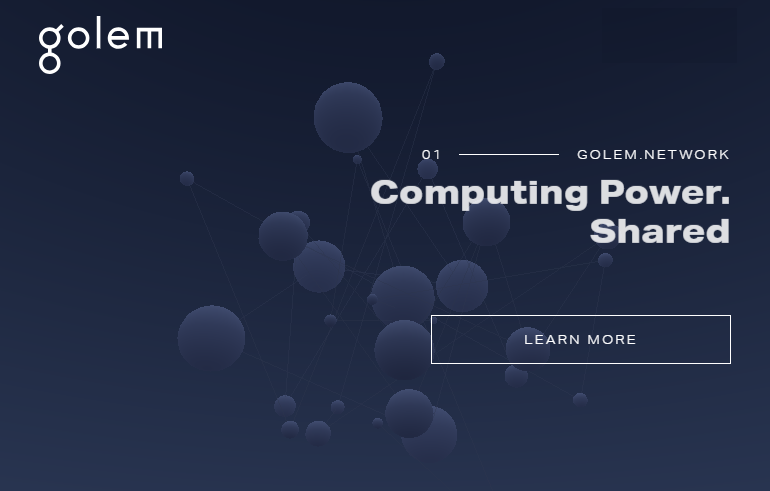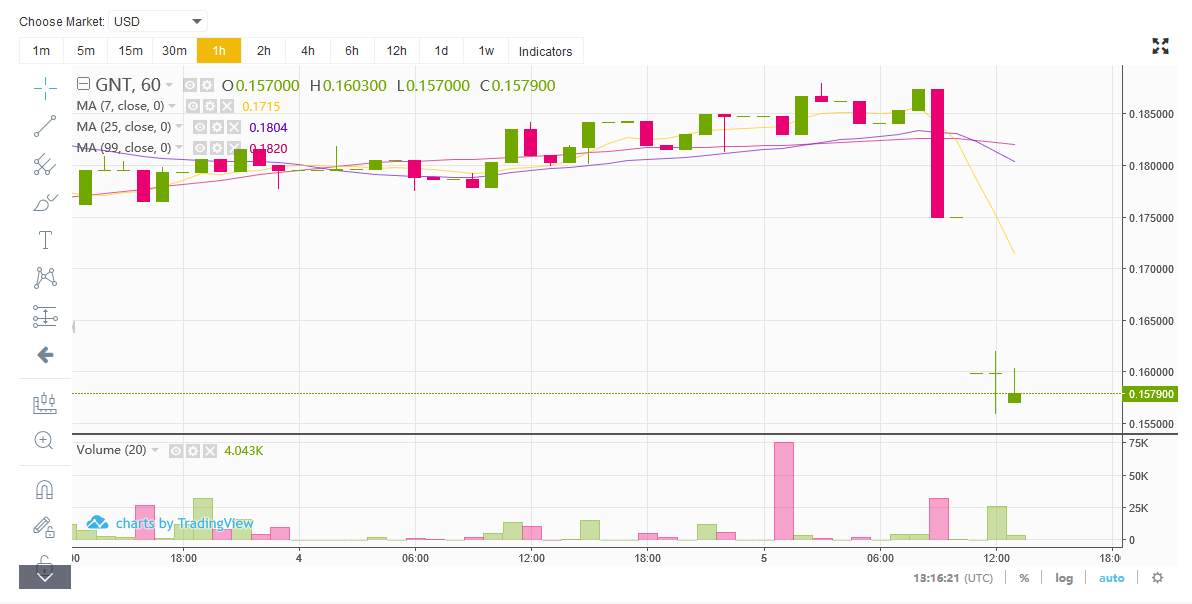Golem (GNT) Review – A Streamlined Blockchain Supercomputer
| Name | Golem |
| Ticker | GNT |
| Total Supply | 820,000,000 |
| Initial Price | $0.0101 |
| Category | Computing |
| Website URL | https://golem.network/ |
| White Paper URL | https://golem.network/crowdfunding/Golemwhitepaper.pdf |
Golem is an open source, decentralized super-computing network that relies on the connected devices of each of its peers to provide power to global users. PCs, laptops, and even large data centers can lend processing power to the network to receive GNT tokens in return. The network’s collective power can be rented by anyone to accomplish complicated computing tasks that would otherwise cost much more. CGI rendering, machine learning, big data analysis and other resource-heavy tasks are made cheaper when employing the communal, decentralized Golem model.
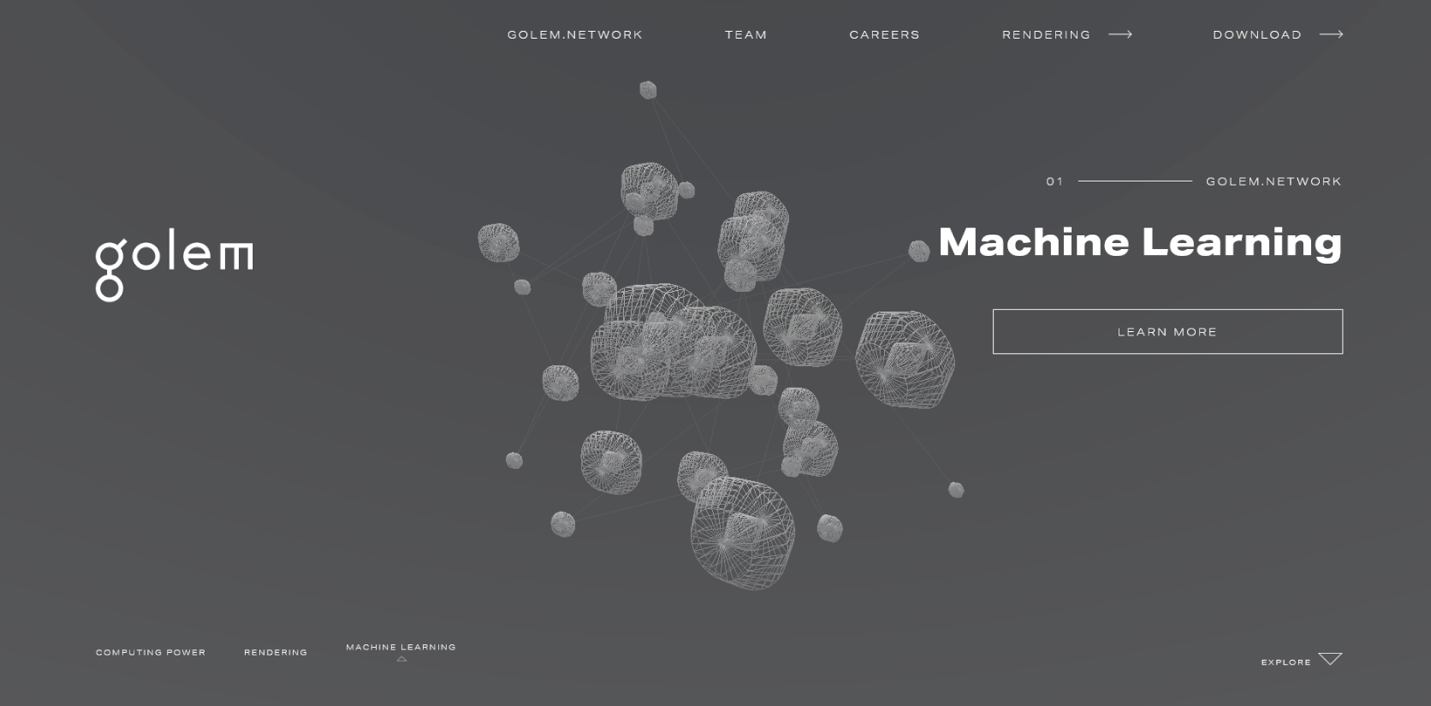
The Idea Behind Golem
A decentralized blockchain network offers users the ability to connect and transact with one another without the influence of centralized authorities, and Golem uses it to create a marketplace for processing and graphical power, denominated in tokens called GNT. Essentially, any user can connect to the Golem network and allow it to borrow their eligible device’s idle power, and they’re paid in GNT depending on how much power they provide. At any given time, Golem can harness an enormous amount of combined power for users to rent.
While power “providers” earn GNT, “requestors” can harness the network’s power for their own purposes by paying in GNT. Where just a few years ago, an animator would need to ship off terabytes of assets to a third-party and pay exorbitant rendering prices, Golem is currently capable of accomplishing the same feat faster and cheaper from within its own application. Requestors simply need to submit their task, set the price they want to pay, and the system will match them with an array of connected Providers who have the necessary amount of power at the right price.
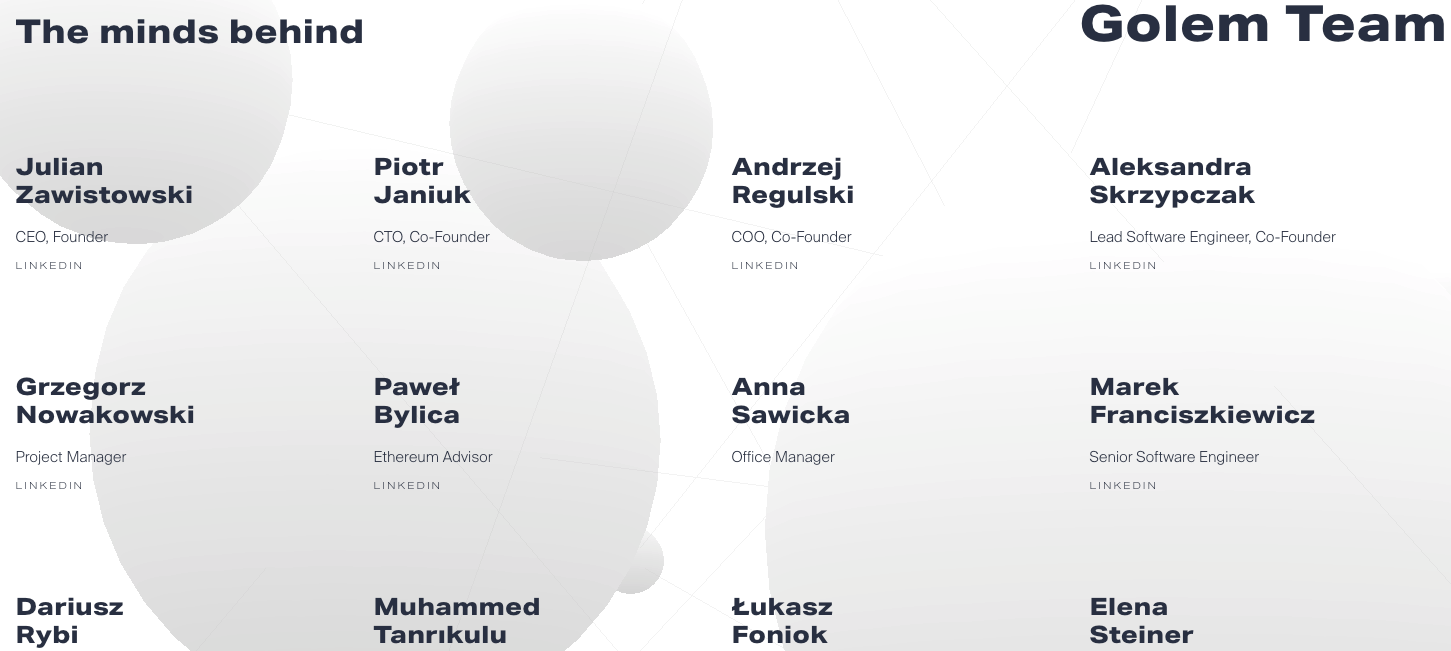
Golem was the first collective super-computing network built on blockchain, and even with new competition in the young space, it maintains its superiority with a blend of technology that makes it a more accessible ecosystem for developers. Such a thoroughly designed platform could only be the brainchild of experts, with CEO Julian Zawistowski at the helm alongside his CTO Piotrek Janiuk, both of whom benefit from extensive hi-tech experience. Zawistowski is an experienced CEO, with founder and advisory roles in several blockchain firms while Janiuk leads the software side thanks to rich experiences in engineering and development.
Golem Partnerships
Golem addresses a sizeable source of demand for both retail and enterprise-level companies and has therefore formed partnerships inside and outside of the blockchain arena. An early one (September 2017) was with Streamr—a decentralized real-time data marketplace—with the intention of the partnership to help both companies lean on each other to grow. Streamr connects to Golem for its low-overhead power, which they need to assign tasks, validate results, manage peer reputation, hone pricing mechanisms and accomplish resource-intensive tasks that the lone decentralized network isn’t entirely capable of handling.
Just a couple months later (and after a successful ICO) Golem landed its second major partnership with Friend Software Corporation—a company that offers a more user-friendly operating system called FriendUP, which has ambitions to be decentralized. Golem donated $750,000 of its ICO earnings to Friend in support of this mission and lends its power and advice in exchange for use of the FriendUP OS in its own ecosystem. Golem has forged several other partnerships in the blockchain arena as well and continues to cement itself as a formative institution within the young industry.
 |
 |
GNT Price History
The Golem ICO began on November 13th, 2016 and ended on the same day—shocking onlookers. As one of the earliest and first ICOs ever, the press was enthralled when Golem managed to quickly raise $8.6 million, hitting their cap within 29 minutes of launch. This was the bar future ICOs measured themselves against, and it doubtlessly inspired many startups and projects on the fence until that point to consider a coin offering as their path towards capitalization.
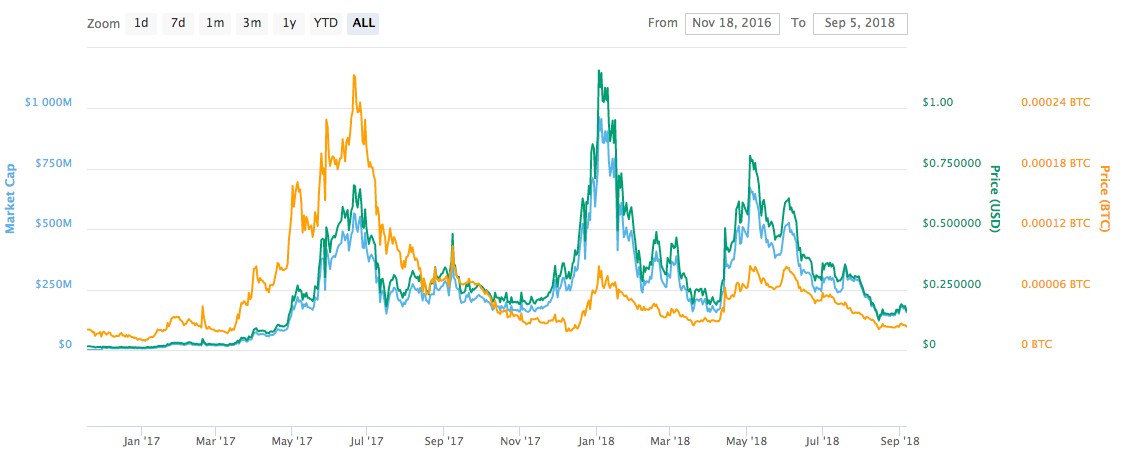
In November 2016, early contributors could purchase GNT tokens for the price of $0.01 using Ethereum. Unlike other projects, most of which were launched in 2017 and suddenly experienced the market’s high level of volatility in that time, GNT sat at around $0.01 for months before moving upwards in May 2017. It spiked to $0.68 in late June before dropping again, trading within the range between $0.15 and $0.20 for the remainder of the year. The end of 2017 saw the token experience the same rally that drove the entire market, with GNT managing to reach at $1.15 for all of one day before falling with the rest.
GNT has been trading lately at what seems to be its “bottom-barrel” price of about $0.15, which represents the low point it has experienced a number of times during both 2017 and 2018.
Golem’s Technology
Golem incorporates an impressive and thorough array of different technological ideas into the platform to make it work. Basically, Requestors can browse a list of task templates for them to fit their job into, specify the price they want to pay and other relevant criteria, and watch as its uploaded to the network’s task manager to be matched to relevant Provider peers. When the task manager finds a suitable task for the Provider to work on, it also checks the reputation of all nodes involved and notifies the network of nodes with a poor reputation.
Given the go-ahead, the Provider receives the work via IPDS (Interplanetary File System) and gets to work. Once the work is verified, the task manager pings an Ethereum smart contract that moves GNT funds between Providers and Requestors as necessary, improving the reputation of all involved. This complicated workflow requires some equally complex technology to work:
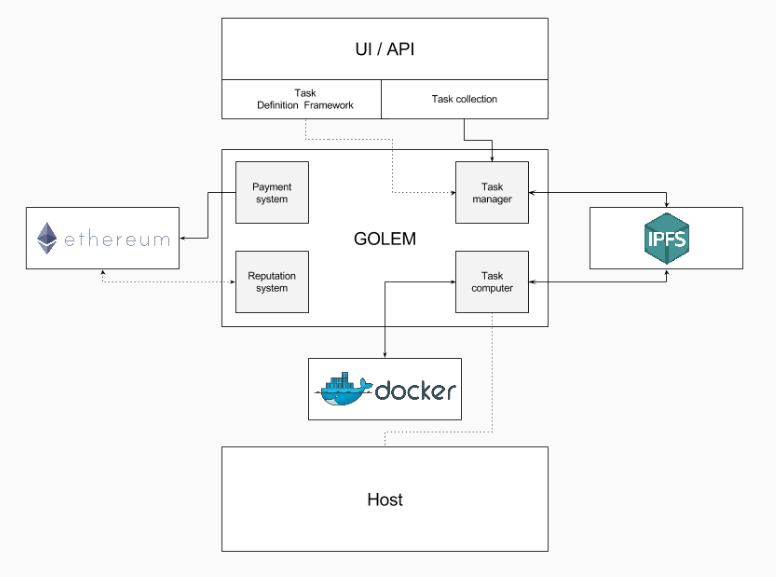
Application Registry
The application registry is a custom smart contract built on Ethereum and connected to the Golem network, allowing developers to publish their own DApps. As an open source project, developers are free to use Golem’s code to deploy and monetize their own applications and Golem-based ideas on the registry.
Transaction Framework
The transaction framework is a part of Golem that enables savvy developers to launch their own task templates on the platform, allowing them (and others) to avoid being pigeonholed into Golem’s default options. They’re also able to customize payment options using this function, which is a utility that’s highly necessary given the platforms variety of purposes.
Docker
A crucial element of the Golem technology stack is Docker, a software that provides operating system-level virtualization capabilities, also known as “containers”. Docker allows subtasks that make up the meat and bones of any parent task on Golem to be hidden from providers. This is an important function, especially when considering companies with valuable assets and intellectual property don’t want to release these assets to those whose only job is to process them in some way. Subtasks run inside a Docker container, and providers are unable to choose which subtask they’re working on, keeping the system airtight.
How to Buy GNT
GNT is traded on a plethora of exchanges, given that it’s been on the market for years now. Across a wide array of popular centralized and decentralized exchanges, the token is tradeable with virtually every common counter currency like Bitcoin, Ethereum, Tether, and others. Of them, Bithumb enjoys the highest daily volume of GNT trading by a wide margin, at 79.69% or $12,023,400. The next biggest exchanges for GNT are no surprise—OKEx and Binance—at 2.67% and 2.22%, respectively. Currently, the price of one GNT is $0.1577.
One of the best ways to purchase GNT is through Binance where it can be traded with ETH, BTC and BNB
Other Exchanges:
- Bithumb (Trade GNT with KRW on Bithumb)
- OKEx (Trade GNT with USDT on OKEx)
- Huobi (Trade GNT with USDT on Huobi)
- Upbit (Trade GNT with KRW on Upbit)
How to Store GNT
As a relatively early coin offering and an Ethereum-based blockchain project, GNT is capable of being stored via a wide range of wallets. One can easily use MyEtherWallet to store their GNT, or they can even keep it on the ERC20-adjacent hardware wallet, the Ledger Nano S. Exodus and Jaxx, also Ethereum-based wallets, are great options, but the list goes on. Always remember to avoid keeping GNT, or any other cryptocurrencies, on the exchange wallet because you don’t control its private key. Virtually any Ethereum-based wallet is a better alternative.
Roadmap and Future Plans
Golem’s roadmap is filled with terminology that might otherwise be at home in a sculptor’s studio, with its various iterations being named Golem Brass, Clay, the upcoming Stone, and in the future, Iron. With many years of patient development and a focus on its community, Golem has made astounding progress. In 2017, Golem opened its public GitHub repository, launched the Brass Golem rendering application, the Clay Golem Task API and Application Registry, and signed a robust list of partners. Unnamed here are the thousands of daily active users the company has earned since founding.
The future is bright for Golem as well, with plans to launch Stone Golem ramping up quickly, which will introduce security and stability upgrades into Clay. Iron is also something to look forward to, and the Golem team has indicated that it will be an almost-complete product, with a sandbox for developers to more freely create and connect applications. As the finishing touches are added, Golem will move from the R&D side to the marketing and business development camp, where it intends to sign larger software companies and development houses which are in dire need of more cutting-edge cloud computing services. One day, the choice between AWS (Amazon Web Services) and Golem may take some serious consideration.

